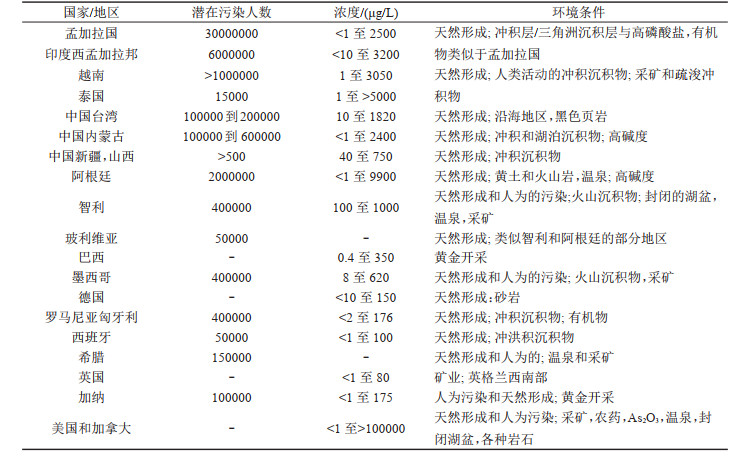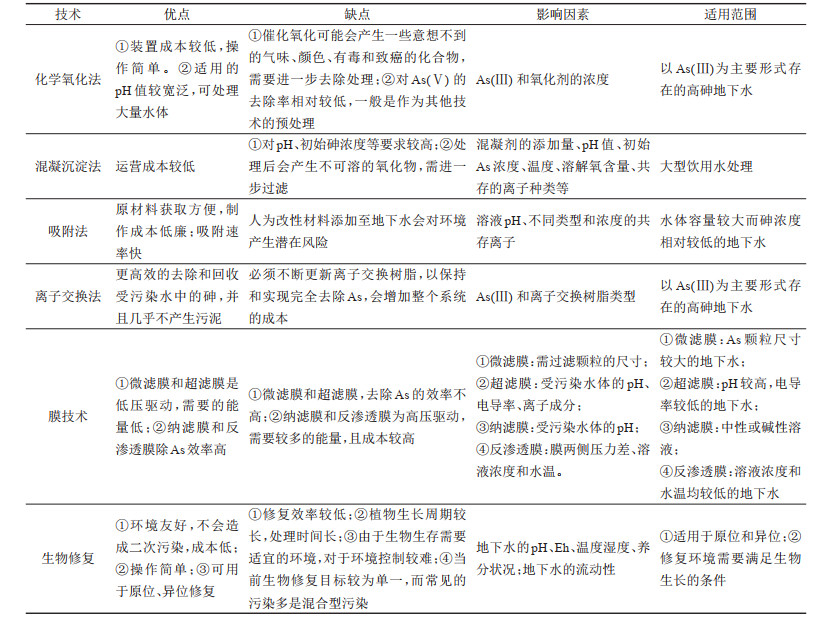2. 河北沧州平原区地下水与地面沉降国家野外科学观测研究站, 河北 石家庄 050061;
3. 中国地质大学 (北京), 北京 100083
2. Hebei Cangzhou Groundwater and Land Subsidence National Observation and Research Station, Shijiazhuang 050061, Hebei, China;
3. China University of Geosciences(Beijing), Beijing 100083, China
[Objective] There are hundreds of millions of people in more than 70 countries in the world facing the threat of high arsenic groundwater. Long-term drinking high-arsenic groundwater will lead to chronic arsenic poisoning, cancer, and seriously endanger health. The distribution of arsenic concentration in groundwater is the result of multiple factors including sedimentary environment, meteorological hydrology, mineral environment, and human activities. Therefore, it is necessary to start from the different physical and chemical properties of arsenic and select appropriate and targeted treatment technologies. [Methods] Based on the current pollution status of arsenic-bearing groundwater, the current situation and progress of arsenic-bearing groundwater treatment were analyzed by comprehensively considering various factors such as removal amount, treatment cost, remediation rate, and reversibility. [Results] This study comprehensively introduces the arsenic-bearing groundwater treatment technology, covering the research results of chemical oxidation, coagulation- sedimentation, adsorption, ion exchange, membrane technology and bioremediation, and shows the removal effect of different types of treatment methods on high- arsenic groundwater. In order to provide a meaningful reference for the comprehensive treatment of arsenic-bearing groundwater, the internal mechanism and the latest optimization measures for the technology are summarized, and the development trend of the arsenic- bearing groundwater treatment technology is prospected. [Conclusions] The current arsenic-bearing water treatment technology has many defects, and the generated waste or sludge may become a potential source of secondary pollution. Therefore, to better protect our environment from As, new mixing techniques and safe disposal methods for As- laden waste/sludge are required. The lack of awareness of drinking water safety and availability in remote areas also presents challenges for arsenic management, so an affordable, easy-tobuild technology that operates at the community or household level is needed to address the problem.
水不仅是生命的重要组成部分,也是维持生活质量的基本组成部分。联合国儿童基金会和世卫组织的报告证实,全世界有7.48亿人没有充足和安全的水资源,超过25亿人无法获得充足的供水,18亿人正在使用被粪便污染的饮用水源(WHO/UNICEF, 2014)。全球有超过50%的人口将地下水用于饮用水,因此,地下水有时被描述为“隐藏的海洋”。在印度等国家,80%的农村和50%的城市住宅供水仅由地下水源提供(Ayoob et al., 2008)。而砷是全球范围内影响人类健康的地下水中最重要的无机污染物之一(Katsoyiannis et al., 2007)。水的砷污染可以通过以下方式发生:天然来源和人类活动。天然来源广泛分布于地壳中,砷的分布受到沉积环境及地层结构的控制和影响(Cao et al., 2017),国内外学者普遍认为地下水中原生砷的含量异常是由于附着在沉积物颗粒上的羟基氧化铁的还原,进而造成吸附的砷被释放所致(Nazari et al., 2017);自然状态下,人为来源主要是由于许多砷化合物用于农业、医药、畜牧业、电子业、工业和冶金业,导致大量的砷被人类排放到自然界(He et al., 2012),进而进入到地下水中。
地下水中的砷异常已经成为全球关注的问题,世界卫生组织(WHO)设定了砷在饮用水中的最高浓度为0.01 mg/L,同时中国《生活饮用水卫生标准》(GB 5749-2006)也将砷的标准定为0.01 mg/L。一般情况下,砷以有机和无机两种形式存在于含水层系统中,且相较而言无机砷的毒性要大得多,并且广泛存在于地下水、地表水和许多食物中(Wen et al., 2020)。长期饮用砷污染的水会造成皮肤癌、肺癌、膀胱癌、肾病、神经和心血管系统疾病等健康问题(Wang et al., 2009; Basu et al., 2014)。但是由于砷对于环境的敏感性,在不同地貌、含水层系统、氧化还原条件下砷的存在形式会发生变化,迁移能力也有显著差异,因此对于含水层中砷的去除需要同时兼具考虑去除量、处理成本、修复速率、可逆性等多种因素。
本文基于现阶段含砷地下水的污染现状,综合国内外研究现状介绍常见的含砷地下水治理技术,详细归纳并揭示各治理技术的机理和技术优劣,并对含砷地下水治理技术存在的问题和发展趋势展开讨论。对去除地下水中砷的不同修复技术进行总结,将有助于全面掌握不同方式除砷的实际可行性,以期为含砷地下水的综合整治提供有意义的参考。
2 含砷地下水的污染现状由于地球成因和地球环境化学的作用(地热、微生物作用等),砷被释放到地下水中,某些地区形成高砷地下水(Zheng et al., 2004)。另外,工业生产活动及杀虫剂、除草剂和化肥的使用也人为地造成了地下水砷污染。
全世界有70多个国家上亿人口面临高砷地下水的威胁(Prosun et al., 2004),孟加拉国及印度的西孟加拉邦将近3600万人口处于饮水型砷污染暴露的风险中,表 1总结了一些典型地区的案例,包括富集的天然来源及与采矿相关的来源(Wang et al., 2000; Gao et al., 2014)。地球上很多地区的含水层中砷浓度高于50 μg/L,尤其在阿根廷、孟加拉国、智利、中国、匈牙利、印度孟加拉州、墨西哥中部、罗马尼亚、越南和美国的西南部等(图 1)(Kazuharu et al., 2010; Ahn, 2012; Zhou, 2017),以及在尼泊尔、缅甸、柬埔寨的部分地区。中国的黄河、淮河等流域内均发现有高砷水的分布(韩双宝等,2021;许乃政等,2021)。一些地区也报告了与地热水有关的砷,地热流体中砷的浓度一般在1~10 mg/L,有的甚至高达50 mg/L(姜舟,2016),包括来自阿根廷、日本、新西兰、智利、堪察加半岛、冰岛、法国、多米尼加岛和美国。虽然地下水中砷的空间变异性极大,且与地层岩性及地形变化有关联,但在全球范围尺度上,高砷地下水与全球构造图表现出显著的系统关联,大部分高砷地下水的富集区域均位于紧邻造山带的沉积盆地内。例如自西欧延伸至中国东部的阿尔卑斯—喜马拉雅造山带、纵贯北美的科迪勒拉造山带以及南美的安第斯造山带,在其紧邻的内陆沉积盆地均发现了较为集中的高砷地下水分布(Guo et al., 2008; Guo et al., 2014)。Bhattacharjee et al. (2005)针对砷的物质来源进行研究,推测内陆盆地中砷在地下水中的富集最终源于板块构造理论的地壳的演化过程,富含砷的岩浆岩由深部携带至浅地表,在浅表的生物地球化学过程中,砷被释放或迁移至地下水中。
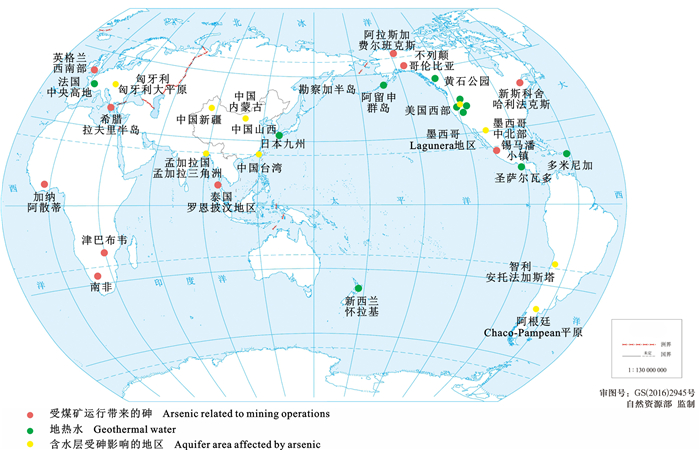
|
图 1 世界高砷地下水分布(据Smedley et al., 2002) Fig. 1 Distribution of High As groundwater in the world (after Smedley et al., 2002) |
|
|
表 1 全球地下水砷污染状况(据Nordstorm, 2002) Table 1 Global arsenic contamination in groundwater(after Nordstorm, 2002) |
研究表明浅层(或主要)含水层的过度开采是许多砷问题的根源(Jakariya et al., 2007)。地下水多为还原环境,砷主要以As(III)为主,以溶解性分子(H3AsO3)的形式存在,毒性大,不易被其他物质所吸附或共沉淀;在氧化条件下,砷主要以As(V)为主,以离子(H2AsO4-,HAsO42-)的形式存在,As(V)毒性比As(Ⅲ)小,而且易被其他物质所吸附或共沉淀(Cullen et al., 1989; Kim et al., 2002; Bose et al., 2002),地下水中砷污染的主要机制是天然岩石中铁氧化物或氢氧化物的解吸附及其还原溶解(Li et al., 2012; Kim et al., 2012),而水中的氧化还原电位(Eh)和pH条件控制着砷的形态。Wang et al.(2006)绘制了水相中砷的氧化状态Eh-pH图。
地下水中砷的浓度除了取决于pH、氧化还原电位等内在因素,还取决于周围地区的岩石、沉积物等化学组成,相邻的地下水井间砷浓度的差异可以达到三个数量级甚至更大。自然条件下,地下水中砷主要来自于水岩之间的相互作用,其存在形态、迁移及转化主要受氧化还原作用、吸附作用和生物化学作用三者的制约,三者共同作用使得在同一水环境中的砷能够以不同的形态同时存在。
3 含砷地下水的治理技术各种常规处理方法已经可用于实验室和现场条件下修复地下水中的砷。最常用的除砷方法即化学氧化、混凝沉淀、吸附、离子交换和膜技术。Rahman et al. (2014)讨论了一种与传统方法不同的方法,并提倡仅利用生物有机体进行As还原,可处理的总砷浓度范围为50~1000 μg/L。然而,一些研究人员已成功处理初始浓度非常高的As (5000~300000 μg/L)(Robins et al., 2005;Song et al., 2006;An et al., 2011)。生物修复技术可以单独工作,也可以与其他常规处理过程联合应用。
总的来说,所有的方法都遵循氧化-还原、吸附和混凝-沉淀伴随过滤的原理。以下将对这些修复技术的研究现状和发展进行分析和总结。
3.1 化学氧化法去除水中As(Ⅲ),需先将As(Ⅲ)氧化为As(V)(Habuda-Stanić et al., 2015),然后经吸附、混凝、过滤等手段去除。因此本文将化学氧化法作为单独的一个技术方法加以讨论。
空气氧化As(Ⅲ)的过程非常缓慢,通常需花费数周时间(Pierce et al., 1982)。因此,要想在短时间内(数分钟)实现As(Ⅲ)氧化,必须通过催化氧化。臭氧、过氧化氢、高锰酸盐、氯和氯胺以及芬顿型试剂等被广泛用于将As(III)氧化为As(V)。对于发展中国家,高锰酸钾可用作将As(III) 氧化为As(V)的廉价试剂。氯是有效的氧化剂之一,但与有机物反应会产生有毒、致癌的三卤甲烷。如果原水含有铁,过氧化氢可作为有效的氧化剂。使用合适的光吸收剂(例如:TiO2)进行紫外线辐射是氧化As(III)的另一种选择(Litter et al., 2010)。对于As(III)和氧化剂,与过氧化氢、臭氧、氯和氯胺以及高铁酸盐的反应都遵循一级动力学,因此As(III)和氧化剂的浓度是有效去除水溶液中As的最重要参数(Mondal et al., 2006)。As(III)氧化为As(V)的反应可以在比较宽泛的pH范围内发生,它有效地增加了砷的吸附亲和性(Virender et al., 2007)。
当用于氧化As(III)时,与过氧化氢和氯胺相比,高锰酸盐、氯和臭氧的反应速度非常快(Pettine et al., 1999;Yunho et al., 2003;Ghurye et al., 2004;Michael et al., 2006)。Kim et al. (2000)报道,只有54%~57%的As(III)可以通过使用空气和纯氧被氧化成As(V),但As(III)的完全氧化只能通过臭氧实现。然而,该过程非常昂贵,因为它需要非常高的能量输入(Jiang,2015)。该过程的主要挑战是去除水中残留的臭氧。Li et al. (2010)报道软锰矿(α-MnO2)在pH值为6.0时可以实现高达90%的砷去除效率,此时氧化和吸附过程连续进行。
在As(III)氧化时,过硫酸根离子(S2O82-)作为一种有效的氧化剂,会通过活化产生高反应性的过硫酸盐自由基,活化所需的能量可以来自紫外线(光化学)或声学(声化学)(Neppolian et al., 2010)。羟基自由基的形成是过硫酸盐反应的主要优点,它有助于生成非常不稳定的As(IV),并立即转化为As(V)。溶解氧的存在会加速此反应,腐殖酸的出现则通过淬灭自由基活化来延缓反应(Neppolian et al., 2010)。
分子氧是另一种常用于As(III)氧化的氧化剂,通过自然表面反应提供到溶液中的氧可以被认为是一种低成本的氧化剂。它易于获取,但效率较低。在铁和锰的存在下,氧化时间被显著缩短,因为富氧水可能会在Fe(II)存在下促进“伪芬顿”型试剂的形成(Kim et al., 2000)。
Criscuoli et al.(2012)报道了MnO2涂层的纳米结构胶囊可以有效氧化As(III)。这种氧化方法适用于砷浓度很低时。在0.1~0.3 mg/L的初始砷浓度下,去除效率达到99%,而对于0.7~1 mg/L的初始砷浓度,去除效率为73%~90%。
在铁和氧存在的情况下,紫外线可以充当光氧化剂。在800 mg/L的铁络合离子存在时,沉淀的氢氧化铁以>0.97 mg/L/min的氧化速率吸附As(V)(Emett et al., 2001),但反应所需的pH值在0.5~2.5的范围内。Hug et al.(2001)的另一项研究指出,在浓度为0.06~5 mg/L的Fe(II, III)和100~200 μL柠檬酸盐存在时,用90 W/m2的UV-A光辐照2~3 h可以去除大于90%的砷(初始浓度为500μg/L)。Lara et al. (2007)得出的结论是,太阳-光和铁-柠檬酸盐配合物可以在辐照1 h内去除80%的初始As(III),而As(V)需要在该条件下4 h才能达到80%的去除率。
3.2 混凝沉淀法使用铁、铝盐的混凝-沉淀技术是目前较为有效的地下水As去除技术之一(Du et al., 2014; Eslami et al., 2019; Rathi et al., 2021),混凝剂中带正电荷的离子通过中和或降低胶体的负电荷引起颗粒的凝聚,溶解态砷被混凝剂转为不溶性固体而沉淀,也可以被吸附在金属氢氧化物上而共沉淀,从而实现砷的去除(Sarkar et al., 2016; Rajni et al., 2017)。常见的用于混凝法的铁盐有硫酸铁、硫酸亚铁、聚合硫酸铁、氯化铁、高铁酸钾等,混凝剂的添加量、pH值、初始As浓度、温度、溶解氧含量、共存的离子种类等均会对地下水中砷的去除效果有一定影响(Meng et al., 2000; Cui et al., 2015; Wang et al., 2020)。磷酸盐和碳酸氢盐,可以与砷物种竞争金属氧化物和氢氧化物的吸附位点(Meng et al., 2000; Wang et al., 2014),钙离子提升砷的吸附比例(Wang et al., 2013)。
铁盐原料成本低,吸附位点密度高,形成的氢氧化铁表面与砷之间的强化学键对砷的吸附能力强,去除砷的性能更优,因此砷去除时更多地选用铁盐(Terracciano et al., 2015; Cui et al., 2015)。Bina et al.(2013)以氯化铁为混凝剂,壳聚糖为助凝剂去除水中砷酸盐和亚砷酸盐,结果表明壳聚糖作为天然助凝剂可提高氯化铁混凝除砷效率,As(V)和As(III)去除率分别达到100%和80%,该方法用于饮用水中初始砷浓度低于1000 μg/L的情景。Muhammad et al.(2021)认为氯化铁去除As的性能在pH值为8~9时降低,硫酸铝除砷的pH值范围比氯化铁更小。
通过优化具有不同电荷的多核羟基配合物,制备出的预水解聚合硫酸铁可以有效控制金属盐在水中的复杂水解反应,从而提高混凝效果。Cheng et al.(2002)研究表明,聚合硫酸铁的荧光猝灭更高,说明其在混凝稀释过程中水解更慢;Fan et al. (2003)通过对比不同混凝条件下聚合氯化铁、聚合硫酸铁、聚合氯化铝、聚合硫酸铝与常规混凝剂的除砷效果,发现聚合混凝剂的除砷效率比常规混凝剂高10%~20%。
一般将As(III)氧化为As(V)后更易去除,因此在混凝前会进行预氧化操作,经过混凝处理后,水中的细沉淀物通过沉降和砂过滤过程从水中去除,该过程可以实现砷去除率的跃升(Sarkar et al., 2016)。Habuda-Stanić et al.(2015)针对潘诺尼亚盆地地下水的高砷问题,对比了不同类型的铁混凝剂(硫酸铁、硫酸亚铁和氯化铁)和不同的氧化剂(高锰酸钾和过氧化氢)组合除砷效果,结果表明三价铁混凝剂和高锰酸钾搭配对砷的去除率较高,对pH依赖较低,二价铁和双氧水搭配对砷的去除率较高,对pH依赖较高。Eslami et al.(2019)利用Fe-Mn双金属纳米氧化物与聚合氯化铁、聚合氯化铝结合可以有效提高除砷效率。Wang et al.(2020)利用高铁酸钾K2FeO4去除砷,既依赖于形成的FeAsO4沉淀,也依赖于配体交换形成的双齿表面络合物的吸附,并且在除砷系统中K2FeO4的氧化显著提高了As(III)的去除率。Cui et al.(2015)运用絮凝和砂滤的双系统,综合了次氯酸钙对砷的氧化和混凝、砂滤去除沉淀和活性炭过滤去除余氯的过程,结果表明该系统是农村家庭配制清洁饮用水的一种有效、低成本的方法,研究了井水中12种阳离子和阴离子对铁混凝法除砷的影响,确定除砷效率与硅酸盐浓度呈显著负相关。
3.3 吸附法 3.3.1 碳基材料(1) 生物炭:生物炭是各生物质在不同热解温度下的缺氧环境所制备而成,其原材料类型广泛,包括作物秸秆、木质生物质、动物废弃物、城市固体废物等多种类型(Meyer et al., 2011),具有成本低廉、制备简便、不易解吸等优点,因此是一种非常有潜力的吸附剂。生物炭的吸附能力主要受比表面积、元素含量和灰分含量等理化性质的影响,不同元素含量的比值一定程度上可以反映生物炭表面的极性、疏水性、碳化程度。生物炭热解温度通常介于200~750℃,不同热解温度会明显改变生物炭的表面官能团类型和化学组分,进而显著影响生物炭的表面理化性质(Amen et al., 2020)。随着碳化温度的增加,生物炭的比表面积会出现增加,极性减小(Chen et al., 2008)。当碳化温度从500℃升至700℃时,生物炭中的脂肪碳会转化变为芳香烃碳(Xiao et al., 2017),同时矿物成分中碱性阳离子含量增加,有利于对砷的吸附。
生物炭对砷的吸附机理受到物理吸附与化学吸附的共同作用,主要包括静电引力、氢键、表面络合和氧化还原作用(Alkurdi et al., 2019;图 2)。生物炭表面活性组分具有得电子能力,使得As(III)被氧化成As(V)而更易被吸附(Sarkar et al., 2016)。对生物炭表面改性可以有效增加其对砷的吸附能力。研究表明锌改性的生松果生物炭对水溶液中As(III)的吸附能力可以达到7 mg/g(Van et al., 2015),利用铁、锰、锌、氢氧化钾(KOH)等改性的生物炭最大吸附量可达到0.43~31.4 mg/g(Vithanage et al., 2017)。而在土壤中使用生物炭可以减弱植物、蔬菜等对砷的吸收(Namgay et al., 2010; Zama et al., 2018)。
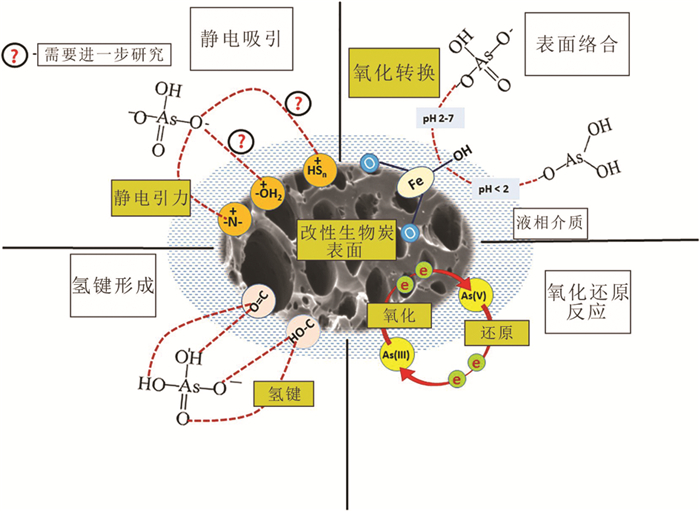
|
图 2 改性生物炭对砷的不同吸附机制(据Alkurdi et al., 2019修改) Fig. 2 Different adsorption mechanisms of modified biochar to arsenic (modified from Alkurdi et al., 2019) |
针对不同原料、不同碳化温度得到的生物炭对于砷的吸附已经有大量的研究,但主要是通过表征手段明确生物炭表面与砷发生作用的官能团类型,针对官能团与砷之间的具体络合方式问题仍需要进一步探究。同时对生物炭与包括零价铁在内的其他高性能吸附剂之间的联合作用研究是一项有潜力的工作。
(2) 碳纳米管:碳纳米管(CNTs)是1991年发现的一种碳质骨架结构的吸附剂(Sumio,1991)。CNTs具有中空结构,体积与表面积大(Lata et al., 2016),特别是表面经过Fe等物质改性过的CNTs通过静电吸附和表面络合作用对砷产生吸附作用,同时还会将As氧化,促进其进一步吸附(Chen et al., 2013)。利用石墨烯-CNT-铁氧化物三维结构的复合物同样由于其较多的孔隙和较大的比表面积对砷产生良好的吸附效果,其最大吸附量超过6 mg/g(Vadahanambi et al., 2013; Sharma et al., 2015)。三维氧化石墨烯片-氧化碳纳米管水凝胶复合物通过催化和吸附协同作用对As(V)的富集量可快速达到258.2 mg/g(Liang et al., 2019)。但是CNTs作为人为制造的产物,其应用对环境产生的潜在风险需要引起重视并进行深入研究(Lata et al., 2016)。
3.3.2 金属骨架材料(1) 二氧化钛(TiO2):二氧化钛理化性质稳定,毒性小,可以有效吸附砷,洗脱后可进行多次再生利用,因此是一种环境友好型的除砷吸附剂(Nabi et al., 2009; Guan et al., 2012; 马文静等, 2018)。肖亚兵等(2003)发现纳米二氧化钛对三价砷和五价砷的吸附率都在99%以上,具有良好的吸附能力。同时TiO2表面带正电荷,对砷可产生快速吸附,几乎在瞬间完成了对As(V)的吸附,同时中性条件下最大吸附量也能达到2.7 mg/g(Jézéquel et al., 2006)。而在TiO2添加Ce(IV)等金属氧化物后,杂化吸附剂可进一步提高对砷的吸附能力(Deng et al., 2010)。研究发现不同二氧化钛的晶型结构、比表面积、吸附点位密度都是影响吸附砷数量的重要因素(Jegadeesan et al., 2010)。
(2) 纳米零价铁(nZVI):纳米零价铁是零价铁处理后粒径控制在1~100 nm的细颗粒吸附剂,其主要优点为比表面积大、还原性强(严子春等,2021)。研究表明nZVI与五价砷会形成稳定络合物,去除量可达到100 mg/g以上(Dong et al., 2012; Li et al., 2017)。但是溶液环境中的pH、小分子酸、溶解氧(DO)等因素会通过竞争吸附位点等机制对nZVI吸附不同价态砷产生抑制作用(冷迎祥等, 2017; 夏雪芬等, 2017; 夏雪芬, 2020)。
(3) 氧化铝:氧化铝作为常见的金属氧化物,获取便捷,具有成本低廉、使用方便等优势,由于其比表面积大和正电荷的表面吸附,其对地下水中五价砷的吸附量可达25 mg/g(Patra et al., 2012;Maity et al., 2021)。研究表明活性氧化铝对砷氧化物的吸附受pH影响较大,当氧化铝表面呈现正电荷时吸附量明显增大(Lin et al., 2001)。
(4) 金属有机骨架:金属有机骨架(MOFs)是金属离子通过配位键与有机配体上的官能团相互作用形成的一种无限结构的配合物(Wang et al., 2014; Xiong et al., 2017),MOFs由于其可调的孔径和高比表面积,可作为很好的砷吸附剂(Rowsell and Yaghi, 2004;Fairen-Jimenez et al., 2011)。MOF根据原材料使用的差异,主要分成UiO(University of Osl)、MIL(Materials of Institute Lavoisier)和ZIF(Zeolitic imidazolate frameworks)三种类型的材料(朱濛等, 2020)。Liu et al. (2015)研究表明沸石咪唑酯骨架结构材料(ZIF-8)对污水中砷的最大吸附达到108 mg/g。Li et al. (2015)经实验得出MOF-808对污水中砷的最大吸附量为84.83 mg/g。吸附机理包括氢键作用、静电引力等(朱濛等,2020)。然而MOF材料很多是通过溶剂热法进行合成,操作复杂且成本较高(Li et al., 2015; 吴桂萍等, 2019)。因此用于地下水中砷去除的MOFs简单、高效且成本低廉的研发合成方式仍需进一步研究。
3.4 离子交换法离子交换是一种物理化学过程,受污染的水中的离子和离子交换剂上有相同电荷的离子相互进行交换,从而去除地下水中砷。离子交换法反应快,分离效果好,适用于较大的pH范围,是一种应用广泛的除砷处理方法(Hu et al., 2018)。美国环保署认为离子交换是目前从饮用水中去除砷的最佳技术之一(An et al., 2011),常见的离子交换法主要有离子交换树脂法和电絮凝法。
3.4.1 离子交换树脂法离子交换树脂是一类带有功能基的网状结构的高分子化合物,其结构由三部分组成:不溶性的高分子三维空间网状骨架、连接在骨架上的功能基团和功能基团所带的相反电荷的可交换离子(张萍等, 2017)。相比其他常规处理方法,使用天然或合成的离子交换树脂法除砷可以更高效地去除和回收受污染水中的砷,并且几乎不产生污泥(Shakoor et al., 2017;Hu et al., 2018)。胡天觉等(1998)合成制备了一种对As(III)离子高效选择性吸附的螯合离子交换树脂,在柱体10 mm×255 mm、常温、pH5.0、流速600 mL/h,含As(III)浓度为5 g/L的溶液脱砷率高于99.99%。
水的pH值、砷浓度、树脂类型以及其他竞争离子是影响离子交换过程的主要因素。比如CO32-、HCO3-、SO42-、Cl-等,由于树脂对这些离子的吸附性大于亚砷酸盐和砷酸盐,因此会影响其对亚砷酸盐和砷酸盐的去除过程。为解决这个问题,An et al. (2005)通过将Cu2+加入螯合离子交换树脂制备了一种聚合物配体交换剂,在pH值6~8范围内此种树脂对砷酸盐的吸附性高于其它干扰离子。Sarkar et al. (2016)研究表明新制备的树脂的平均砷酸盐/硫酸盐分离系数几乎是其他市售树脂的100倍。Puttamraju et al. (2006)利用金属化合物(HFO/Fe3O4、HFO、HFO/ZrO2)对离子交换树脂进行了改性,增强了离子交换树脂对砷的吸附选择性。虽然离子交换树脂法已经得到了广泛的应用,且前景广阔,但是必须不断更新离子交换树脂,以保持和实现完全去除As,这可能会增加整个系统的成本(Shakoor et al., 2016; Aliaskari et al., 2021)。
3.4.2 电絮凝法除砷电絮凝法除砷是在直流电源的作用下,促使可溶性金属阳极如铁、铝、锌等氧化溶解,产生大量金属阳离子,与此同时,阴极板附近的氢离子还原,生成OH-。在阳极形成的金属离子与在阴极产生的氢氧化物结合,产生金属氢氧化物,对污染物有很好的吸附作用,以此实现污水中砷的去除(Nidheesh et al., 2017)。电絮凝法去除污染物的机理如图 3所示。电絮凝法除砷是一种很有发展前景的去除溶液中砷的处理技术,目前许多政府和企业都将该方法作为一种有效的砷去除技术(Amrose et al., 2014; Nidheesh et al., 2017)。Kobya et al. (2011)比较了铝和铁对水中亚砷酸盐的去除效率,并观察到两种电极在75×10-6至500×10-6的亚砷酸盐浓度的去除效率相似。
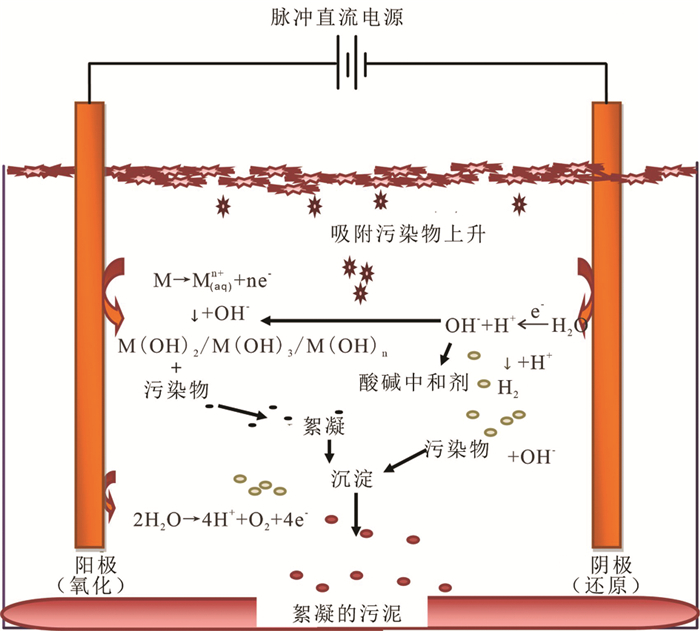
|
图 3 电絮凝法去除污染物机理图(据Nidheesh et al., 2017) Fig. 3 Pollutant removal mechanism by electrocoagulation process (after Nidheesh et al., 2017) |
电絮凝法除砷具有以下优点:设备简单耐用,去除率高,不添加或少添加化学品,保留时间短,不需要使用化学品预氧化As(III)到As(V),无需调整pH值,生成的污泥量少,稳定性好并且使用简单(Mólgora et al., 2013; Amrose et al., 2014; Song et al., 2017)。其不足之处主要体现在阳极金属的高成本及电极上可能形成阻电的氧化膜,影响反应的进行。
3.5 膜技术膜技术使用的膜属于合成材料,具有成百上千亿个孔或微孔,可对液体成分进行选择,从而过滤掉有害物质。根据压力和孔径的不同,该技术细分为微滤(MF)、超滤(UF)、纳滤(NF)和反渗透(RO)几种类型。前两种属于低压驱动膜,去除As的作用过程主要为机械筛分;后两种属于高压驱动膜,去除As的作用过程为毛细管流和溶液扩散(Shih, 2005; Choong et al., 2007)。四种压力驱动膜的工艺特点如图 4所示。
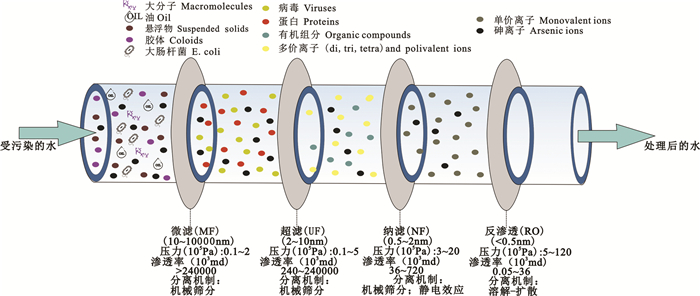
|
图 4 压力驱动膜工艺及其特点(据Rezende et al., 2021) Fig. 4 Overview of pressure-driven membrane processes and their characteristics (after Rezende et al., 2020) |
微滤是一种低压驱动过程,用于分离颗粒直径超过10 μm的胶体和悬浮颗粒。由于地下水中溶解的As(III)和As(V)离子尺寸都较小,因此,采用微滤技术之前,首先需要通过混凝、絮凝或吸附等方法来增加As颗粒的尺寸,从而达到微滤膜的去除条件(Meng et al., 2000;Han et al., 2002;Chwirka et al., 2004;Ghurye et al., 2004)。Han et al. (2002)将絮凝方法与微滤技术结合使用,发现受As的去除率达到了95.1%。Nguyen et al. (2009)先利用纳米铁吸附As(V),然后通过微滤膜过滤,As的去除率达到了90%,相比单纯使用微滤膜过滤,As(V)的去除率提高了约50%。
3.5.2 超滤技术超滤也是一种低压驱动过程,超滤膜孔径介于2~10 nm,由于As离子很小,极易通过超滤膜,因此主要采用带电的超滤膜来去除As。去除机理为:As离子和带负电的超滤膜表面会发生静电排斥作用,导致了As离子不能通过膜表面,从而起到除砷的效果。一般带电的超滤膜对As(III)和As(V)的去除率分别可达到50%和60%(Brandhuber et al., 2001)。但是二价离子和天然有机物会影响As的去除率。当As(V)与二价阳离子(如Ca2+、Mg2+)共存时,超滤膜对As(V)的去除率几乎降为0,这是由于超滤膜上的电荷被中和影响到膜对As的静电排斥。然而,二价离子存在时,溶液中的天然有机物又会提高As(V)的去除率,原因是天然有机物吸附在超滤膜表面形成负电层,导致超滤膜上的电荷密度升高,从而提升了除As(V)效果(Singh et al., 2015)。此外,pH升高和溶液电导率下降,会影响超滤膜表面的极性,从而间接提高As的去除效率。Yoon et al.(2009)进行了3组实验,发现在pH=8、溶液电导率为30 mS/m条件下,As的去除率为80%;控制电导率不变,pH降为4,As的去除率降为67%;而控制pH不变,将溶液电导率提高至121 mS/m,As的去除率降为61%。
3.5.3 纳滤技术纳滤是一种高压驱动过程,纳滤膜孔径为0.5~2 nm,其表面带电荷,通过电荷的相互作用可以分离单价离子和多价离子,从而将As有效去除(Figoli et al., 2010)。虽然相比微滤和超滤技术需要更高的能量,但去除效果更好,因此,纳滤技术具有较为广泛的应用(He et al., 2018)。一般情况下,带电荷的纳滤膜对As(V)的去除率超过90%(Waypa et al., 1997;Zhao et al., 2012)。溶液的酸碱性会影响纳滤膜的除砷效果,通常酸性溶液会导致纳滤膜失去电荷,进而对As的去除产生影响(Waypa et al., 1997)。目前,纳滤技术的研究重点是对膜进行改性,比如合成聚合物膜,该类纳滤膜对As的去除率一般可以达到95%以上。
3.5.4 反渗透技术反渗透是一种高压驱动过程,反渗透膜孔隙极小,一般孔径小于0.5 nm,相较纳滤技术,需要更高压力。对小分子质量的化合物和离子有非常好的去除效果(Velizarov et al., 2004)。通常对As(V)的去除率可达90%以上,但对As(III)的去除效率低于70%(Yoon et al., 2009)。研究发现影响反渗透膜除As的因素包括:压力差、溶液浓度和水温。压力差的提升会促进As的去除,但溶液浓度、水温与除As效率成反比(Abejón et al., 2015; Wenten et al., 2016; Swaminathan et al., 2019)。
3.6 生物修复生物修复是指利用细菌、真菌、植物,甚至是整个微生物-植物系统来富集、浓缩甚至转化地下水中的砷,以降低其毒性而达到除砷目的。生物修复因其环境友好和成本效益高等优势受到广泛关注(Bhattacharya et al., 2021)。生物修复技术主要包括微生物修复技术和植物修复技术。
3.6.1 微生物修复微生物除砷是指从富砷或贫砷环境中筛选得到耐砷菌,利用耐砷菌实现去除地下水中的砷。主要的除砷机理为微生物吸附、微生物作为电子受体氧化三价砷、微生物分泌各种酶使砷甲基化(李妍丽, 2012),详细的作用过程见图 5。
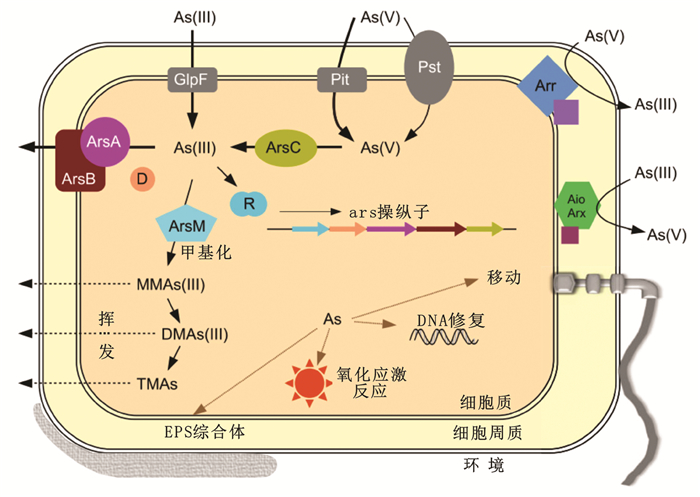
|
图 5 细菌对砷的作用示意图(据Kruger et al., 2013) Fig. 5 Schematic diagram of the effect of bacteria on arsenic (after Kruger et al., 2013) |
细菌将As(III)氧化为As(V)最早由Clark et al.(1918)报道。自然界中有多种微生物可以将As(III)物质氧化为As(V)(Kowalski, 2014)。砷黄铁矿被细菌氧化过程中会产生砷酸,并在两步中和反应中通过与铁和硫酸盐共沉淀得到去除。砷酸铁具有足够的不溶性和稳定性,中和后的液体随后被纯化,并可在细菌氧化回路中重新使用。Katsoyiannis et al.(2004)的研究表明,在有氧条件下亚砷酸盐氧化细菌将As(III)转化为As(V)。
环境中存在的不同种类的细菌可以氧化砷,但能用于含砷地下水治理的细菌很少(Kowalski, 2014)。致病性是选择砷修复细菌种类的重要标准之一。Battaglia-Brunet et al.(2002)研究成果表明,CASO1种群是能够将As(III)氧化的不同生物的混合物,主要包含硫单胞菌(Thimonas)和皮氏罗尔斯顿菌(Ralstonia pickettii)。该混合物的重要特性是(1) 它可以在很宽的pH值、温度和As(III)浓度范围内起作用;(2)由于它是自养的,对营养的需求非常低;(3)氧化As(III) 能力强。Gallionella ferruginea和Leptothrix ochracea是用于砷氧化的两种铁氧化细菌。Katsoyiannis et al.(2004)报告指出,细菌不仅可以有效地氧化As(III),而且有助于从地下水中轻松吸附和去除砷。
Casiot et al.(2006)指出,除了Gallionella ferruginea和Leptothrix ochracea,还有其他可以促进As(III)氧化的细菌种类。从首次报道细菌氧化亚砷酸盐的案例至今已发现几十种类型的菌株,包括异养菌和自养菌。Bachate et al. (2012)研究发现Archromobactor sp. SPB-31菌株的最高氧化速率为19.76×10-9μM·min-1·cell-1。细菌氧化砷的速率与地下水中的pH值有关,砷化硫单胞菌在pH≤4的环境氧化速率最高,而大多数细菌最适的环境pH是5~7。在砷酸还原酶细胞质酶的帮助下,通过直接利用不同的微生物作为细胞内的解毒剂来还原砷酸盐。无机砷酸可以通过肠杆菌和无色杆菌转化为一或二甲基砷(Cullen et al., 1989)。
藻类可以在受砷污染的地下水中进行生物富集和生物转化,不同藻类拥有不同的砷富集能力。单细胞蓝藻Synechocysis对As(III)和As(V)富集浓度分别为0.9和1.0 mg/kg(Yin et al., 2021);Sadia et al.(2021)发现藻类Scenedesmus对As(III)和As(V)的累积浓度分别为606和761 μg /g。
真菌去除砷主要有3个过程: 真菌表面对砷的生物吸附、细胞内砷的沉积和挥发。Srivastava et al.(2011)以4种真菌为研究对象,结果表明,通过吸附和富集作用,五价砷的去除率为27.6%~60.2%,而通过生物挥发作用的去除率为25.5%~29.9%。
3.6.2 植物修复植物修复是一种利用植物修复受金属污染的水的一种方法,其通过不同的机制运作,如固定化(植物稳定化),去除(植物提取),蒸发(植物演化),或降解(植物降解,根际降解)(Placek et al., 2016; Sylvain et al., 2016; Limmer et al., 2016)。植物修复因其具有成本效益高、可用于原位修复、环境友好性、对周围生物多样性的负面影响小等优点而受到越来越多的关注。
不是所有的植物都适合修复砷。修复植物种类的选择依据是:(1)在污染环境中生长率高;(2)与水接触部分的比表面积大;(3)易位能力强。Kumar et al.(2015)指出,45个不同科的超过450个植物种可以超累积As。在实验室和田间条件下,对沉水、浮水和挺水植物进行了富集砷的能力试验。蜈蚣草是砷超富集生物的一个重要例子,每克干重可以累积多达20 mg的砷(Vetterlein et al., 2009; Cesaro et al., 2015)。在过去几年中发现了具有更大除砷潜力的植物,即P. vittata (Ma et al., 2001)。
4 问题及讨论 4.1 治理技术分析及优选本文基于现阶段含砷地下水的污染现状,全面介绍了含砷地下水治理技术,涵盖了化学氧化、混凝沉淀、吸附、离子交换、膜技术和生物修复等方面的研究成果,展现了不同类型处理方式对地下水中砷的去除效果,总结各技术发挥除砷效果的内在机理及最新优化措施。尽管这些方法已被证明可以成功去除地下水中的砷,但每种方法都有其局限性,可能并不适用于所有的现场条件。
As(III)预氧化成As(V)对于提高砷吸附率非常重要。直接氧化也是一种选择,芬顿型试剂、高锰酸盐、氯胺、氯、过硫酸盐、软锰矿可用于化学氧化但该方法对As(V) 的去除率相对较低,一般是作为其他技术的预处理。
混凝沉淀法是一种传统的水净化方法。然而,该过程需要大量的化学品,并且污泥处理比较困难,且价格高昂。与传统混凝工艺相比,电凝产生的污泥较少,可用于小型社区级处理。然而,它需要高能量且效率较低。
吸附法是在社区和家庭层面处理水的一种行之有效的技术,但竞争离子和有机物的存在对吸附具有深远的影响。而且,吸附剂的功效和处理成本决定了该过程的成功与否。用过的吸附剂的处理也是一项重大挑战。
目前去除As最有效的处理方法是离子交换和膜技术。然而,这两个过程费用高昂,受影响最严重的经济不发达地区的人群可能负担不起。除了运营成本外,农村群众还面临着抽水、清洗污膜、供电受限(或不规律)等一系列问题。
生物修复因其环境友好性和成本效益高等优势受到广泛关注,但修复效率低、周期长导致实际应用受到很大的限制。
表 2给出了现有含砷地下水技术的优劣和影响因素。为了更好地保护我们的环境免受As的影响,需要新的混合技术以及对As负载废物/污泥的安全处置方法。而综合治理技术将本领域各种成熟或先进的技术方法组合在一起,能弥补单一方法的不足,取长补短,提高治理效果。
|
|
表 2 治理技术方法的对比分析 Table 2 Comparative analysis of treatment methods |
本文所列各种治理方法有助于筛选不同技术,寻找最优的低成本含砷地下水治理技术,最终在砷污染严重的国家或地区应用。在选择正确的治理技术时必须考虑几个因素,包括As浓度、地下水流速、水化学、As形态、污泥生成、易于操作、电力供应和处理成本。当地的社会经济条件和供水源类型也是选择技术的重要因素。另一个需要考虑的因素是受影响地区是否需要集中、半集中或独立的家庭处理系统。基于含砷地下水治理技术的现状及发展趋势,对含砷地下水修复的发展方向提出以下几点展望:
(1) 尽管有几种大中型去除技术可用于砷的去除,但迫切需要开发农村分散用水的砷去除技术。使用的材料应该是天然可用的,在市场上或在实验室中很容易制备,具有在中性pH值下成本低且效率高。此外,还必须考虑新的配水形式,如罐装饮用水、双管网、家用设备等。这些配水方式应该受到监管,以保证输送的水的质量。使用家用设备应经有关部门批准。
(2) 含砷废物仍然是一个尚未解决的问题。将As负载材料隔离以进行最终永久处置或掩埋而没有任何污染风险的创新封装方法,是下一步研究的重点。
5 结论随着对公共卫生和人类健康的重视,近年来,人们越来越多地关注含砷地下水的污染和砷中毒问题,这在一定程度上促进了含砷地下水治理技术的发展与完善。目前针对含砷地下水的污染问题,已经开发了包括化学氧化、混凝沉淀、吸附、离子交换、膜技术和生物修复在内的许多处理技术。
(1) 本文所列各种治理方法展现了不同类型处理方式对地下水中砷的去除效果,总结了各技术发挥除砷效果的内在机理及最新优化措施,有助于筛选不同技术,寻找最优的低成本含砷地下水治理技术,最终在砷污染严重的国家或地区应用。
(2) 砷在地下水中的迁移转化规律受到各类因素影响,全面认识并阐明砷在地下水微环境中的污染机理和过程,是选择地下水修复技术的重要基础。
(3) 修复方法以常规的技术为基础,针对不同类型地区的污染特点,因地制宜的选择单一或多重联合修复技术,在新型修复技术开发领域,要遵循环保、经济和高效的原则,开发和实施低成本、可持续和混合的技术,以克服去除As的单个过程的缺点。
(4) 此外,目前的砷污染水处理技术存在诸多缺陷,产生的废物或污泥可能成为二次污染的潜在来源。因此,为了更好地保护我们的环境免受As的影响,需要新的混合技术以及对As负载废物/污泥的安全处置方法。缺乏地下水饮用水安全意识和偏远地区的适用性也给砷的治理带来了挑战,因此需要一种价格合理、易于构建、在社区或家庭层面运行的技术来解决这个问题。
Abejón Azucena, Garea Aurora, Ángel Irabien. 2015. Arsenic removal from drinking water by reverse osmosis: Minimization of costs and energy consumption[J]. Separation and Purification Technology, 144: 46-53. DOI:10.1016/j.seppur.2015.02.017 |
Ahn Joo. 2012. Geochemical occurrences of arsenic and fluoride in bedrock groundwater: A case study in Geumsan County, Korea[J]. Environmental Geochemistry & Health, 34(1): 43-54. |
Aliaskari Mehran, Andrea I S. 2021. Nitrate, arsenic and fluoride removal by electrodialysis from brackish groundwater[J]. Water Research, 190: 116683. DOI:10.1016/j.watres.2020.116683 |
Alkurdi Susan S A, Herath Indika, Bundschuh Jochen, Raed A Al-Juboori, Vithanage Meththika, Mohan Dinesh. 2019. Biochar versus bone char for a sustainable inorganic arsenic mitigation in water: What needs to be done in future research[J]. Environment International, 127: 52-69. DOI:10.1016/j.envint.2019.03.012 |
Amalia Terracciano, Jie Ge, Xiaoguang Meng. 2015. A comprehensive study of treatment of arsenic in water combining oxidation, coagulation, and filtration[J]. Journal of Environmental Sciences, 36(10): 178-180. |
Amen Rabia, Bashir Hamna, Bibi Irshad, Sabry M Shaheen, Nabeel Khan Niazi, Shahid Muhammad, Muhammad Mahroz Hussain, Antoniadis Vasileios, Muhammad Bilal Shakoor, Samir G Al-Solaimani, Wang Hailong, Bundschuh Jochen, Rinklebe Jörg. 2020. A critical review on arsenic removal from water using biochar-based sorbents: The significance of modification and redox reactions[J]. Chemical Engineering Journal, 396: 125195. DOI:10.1016/j.cej.2020.125195 |
Amrose Susan E, Bandaru Siva R S, Delaire Caroline, Genuchten Case M van, Dutta Amit, DebSarkar Anupam, Orr Christopher, Roy Joyashree, Das Abhijit, Gadgil Ashok J. 2014. Electro-chemical arsenic remediation: Field trials in West Bengal[J]. Science of the Total Environment, 488/489: 539-546. DOI:10.1016/j.scitotenv.2013.11.074 |
An Byungryul, Liang Qiqi, Zhao Dongye. 2011. Removal of arsenic(V) from spent ion exchange brine using a new class of starch-bridged magnetite nanoparticles[J]. Water Research, 45(5): 1961-1972. DOI:10.1016/j.watres.2011.01.004 |
An Byungryul, Thomas R Steinwinder, Zhao Dongye. 2005. Selective removal of arsenate from drinking water using a polymeric ligand exchanger[J]. Water Research, 39(20): 4993-5004. DOI:10.1016/j.watres.2005.10.014 |
Arif Sadia, Saqib Hira, Mubashir Muhammad, Malik Shaukat Iqbal, Mukhtar Ahmad, Saqib Sidra, Ullah Sami, Show Pau Loke. 2021. Comparison of Nigella sativa and Trachyspermum ammi via experimental investigation and biotechnological potential[J]. Chemical Engineering and Processing-Process Intensification, 161: 108313. DOI:10.1016/j.cep.2021.108313 |
Ayoob S, Gupta A K, Bhat Venugopal T. 2008. A conceptual overview on sustainable technologies for the defluoridation of drinking water[J]. Critical Reviews in Environmental Science & Technology, 38(6): 401-470. |
Bachate Sachin P, Khapare Rashmi M, Kodam Kisan M. 2012. Oxidation of arsenite by two β-proteobacteria isolated from soil[J]. Applied Microbiology and Biotechnology, 93(5): 2135-2145. DOI:10.1007/s00253-011-3606-7 |
Basu Ankita, Saha Debabrata, Saha Rumpa, Ghosh Tuhin, Saha Bidyut. 2014. A review on sources, toxicity and remediation technologies for removing arsenic from drinking water[J]. Research on Chemical Intermediates, 40(2): 447-485. DOI:10.1007/s11164-012-1000-4 |
Battaglia-Brunet F, Dictor M C, Garrido F, Crouzet C, Morin D, Dekeyser K, Clarens M, Baranger P. 2002. An arsenic(III)-oxidizing bacterial population: Selection, characterization, and performance in reactors[J]. Journal of Applied Microbiology, 93(4): 656-667. DOI:10.1046/j.1365-2672.2002.01726.x |
Bhattacharjee Santanu, Chakravarty Sanchita, Maity S, Dureja V, Gupta K K. 2005. Metal contents in the groundwater of Sahebgunj district, Jharkhand, India, with special reference to arsenic[J]. Chemosphere, 58(9): 1203-1217. DOI:10.1016/j.chemosphere.2004.09.055 |
Bhattacharya Sayan, Sharma Prabhakar, Mitra Sayantan, Mallick Ivy, Ghosh Abhrajyoti. 2021. Arsenic uptake and bioaccumulation in plants: A review on remediation and socio-economic perspective in Southeast Asia[J]. Environmental Nanotechnology, Monitoring & Management, 15: 100430. |
Bose Purnendu, Sharma Archana. 2002. Role of iron in controlling speciation and mobilization of arsenic in subsurface environment[J]. Water Research, 36(1): 4916-4926. |
Brandhuber Philip, Amy Gary. 2001. Arsenic removal by a charged ultrafiltration membrane——influences of membrane operating conditions and water quality on arsenic rejection[J]. Desalination, 140(1): 1-14. DOI:10.1016/S0011-9164(01)00350-2 |
Cao Wengeng, Guo Huaming, Zhang Yilong, Ma Rong, Li Yasong, Dong Qiuyao, Li Yuanjie, Zhao Ruike. 2017. Controls of paleochannels on groundwater arsenic distribution in shallow aquifers of alluvial plain in the Hetao Basin, China[J]. Science of the Total Environment, 613-614(1): 958-968. |
Casiot C, Pedron V, Bruneel Odile, Duran Robert, Personné Jean Christian, Gérard Grapin, Drakidès Christian, Elbaz-Poulichet Françoise. 2006. A new bacterial strain mediating as oxidation in the Fe-rich biofilm naturally growing in a groundwater Fe treatment pilot unit[J]. Chemosphere, 64(3): 492-496. DOI:10.1016/j.chemosphere.2005.11.072 |
Cesaro Patrizia, Cattaneo Chiara, Bona Elisa, Berta Graziella and Cavaletto Maria. 2015. The arsenic hyperaccumulating Pteris vittata expresses two arsenate reductases[J]. Scientific Reports, 5(1): 14525. DOI:10.1038/srep14525 |
Chen Baoliang, Zhou Dandan, Zhu Lizhong. 2008. Transitional adsorption and partition of nonpolar and polar aromatic contaminants by biochars of pine needles with different pyrolytic temperatures[J]. Environmental Science & Technology, 42(14): 5137-5143. |
Chen Bo, Zhu Zhiliang, Ma Jie, Qiu Yanling, Chen Junhong. 2013. Surfactant assisted Ce-Fe mixed oxide decorated multiwalled carbon nanotubes and their arsenic adsorption performance[J]. Journal of Materials Chemistry A, 1(37): 11355-11367. DOI:10.1039/c3ta11827d |
Cheng Wenpo. 2002. Comparison of hydrolysis/coagulation behavior of polymeric and monomeric iron coagulants in humic acid solution[J]. Chemosphere, 47(9): 963-969. DOI:10.1016/S0045-6535(02)00052-8 |
Choong Thomas S Y, Chuah T G, Robiah Y, Gregory Koay F L, Azni I. 2007. Arsenic toxicity, health hazards and removal techniques from water: An overview[J]. Desalination, 217(1/3): 139-166. |
Clark William Mansfield. 1918. The differentiation of bacteria of the Colon-Aerogenes family[J]. American Water Works Association, 5(1): 26-32. DOI:10.1002/j.1551-8833.1918.tb11649.x |
Criscuoli Alessandra, Majumdar Swachchha, Figoli Alberto, Sahoo Ganesh C, Bafaro Patrizia, Bandyopadhyay Sibdas, Drioli Enrico. 2012. As(III) oxidation by MnO2 coated PEEK-WC nanostructured capsules[J]. Journal of Hazardous Materials, 211-212: 281-287. DOI:10.1016/j.jhazmat.2011.11.023 |
Cui Jinli, Jing Chuanyong, Che Dongsheng, Zhang Jianfeng, Duan Shuxuan. 2015. Groundwater arsenic removal by coagulation using ferric(III) sulfate and polyferric sulfate: A comparative and mechanistic study[J]. Journal of Environmental Sciences, 32: 42-53. DOI:10.1016/j.jes.2014.10.020 |
Cullen William R, Reimer Kenneth J. 1989. Arsenic speciation in the environment[J]. Chemical Reviews, 89(4): 713-764. DOI:10.1021/cr00094a002 |
Deng Shubo, Li Zhijian, Huang Jun, Yu Gang. 2010. Preparation, characterization and application of a Ce-Ti oxide adsorbent for enhanced removal of arsenate from water[J]. Journal of Hazardous Materials, 179(1): 1014-1021. |
Dong Haoran, Guan Xiaohong, Lo Irene M C. 2012. Fate of As(V)-treated nano zero-valent iron: Determination of arsenic desorption potential under varying environmental conditions by phosphate extraction[J]. Water Research, 46(13): 4071-4080. DOI:10.1016/j.watres.2012.05.015 |
Du Jingjing, Jing Chuanyong, Duan Jinming, Zhang Yongli, Hu Shan. 2014. Removal of arsenate with hydrous ferric oxide coprecipitation: Effect of humic acid[J]. Journal of Environmental Sciences, 26(2): 240-247. DOI:10.1016/S1001-0742(13)60437-4 |
Emett Maree T, Khoe Ging H. 2001. Photochemical oxidation of arsenic by oxygen and iron in acidic solutions[J]. Water Research, 35(3): 649-656. DOI:10.1016/S0043-1354(00)00294-3 |
Eslami Hadi, Ehrampoush Mohammad Hassan, Esmaeili Abbas, Salmani Mohammad Hossein, Ebrahimi Ali Asghar, Ghaneian Mohammad Taghi, Falahzadeh Hossein, Reza Fouladi Fard. 2019. Enhanced coagulation process by Fe-Mn bimetal nano-oxides in combination with inorganic polymer coagulants for improving As(V) removal from contaminated water[J]. Journal of Cleaner Production, 208: 384-392. DOI:10.1016/j.jclepro.2018.10.142 |
Fairen-Jimenez D, Moggach S A, Wharmby M T, Wright P A, Parsons S, Düren T. 2011. Opening the gate: Framework flexibility in ZIF-8 explored by experiments and simulations[J]. Journal of the American Chemical Society, 133(23): 8900-8902. DOI:10.1021/ja202154j |
Fan Maohong, Brown Robert C, Sung Shin Wu, Huang Chin-Pao, Ong Say K, van Leeuwen J. 2003. Comparisons of polymeric and conventional coagulants in Arsenic(V) removal[J]. Water Environment Research, 75(4): 308-313. DOI:10.2175/106143003X141114 |
Farid Hesami, Bijan Bina, Afshin Ebrahimi, Mohammad Mehdi Amin. 2013. Arsenic removal by coagulation using ferric chloride and chitosan from water[J]. International Journal of Environmental Health Engineering, 2(1): 17. DOI:10.4103/2277-9183.110170 |
Figoli Alberto, Cassano Alfredo, Criscuoli Alessandra, Mozumder M S I, Uddin M Tamez, Islam M Akhtarul, Drioli Enrico. 2010. Influence of operating parameters on the arsenic removal by nanofiltration[J]. Water Research, 44(1): 97-104. DOI:10.1016/j.watres.2009.09.007 |
Gao Yichun, Wang Yanxin, Duan Yanhua, Deng Yamin, Guo Xinxin, Ding Xufeng. 2014. Hydrogeochemistry and arsenic contamination of groundwater in the Jianghan Plain, central China[J]. Journal of Geochemical Exploration, 138: 81-93. DOI:10.1016/j.gexplo.2013.12.013 |
Ghurye Ganesh, Clifford Dennis, Tripp Anthony. 2004. Iron coagulation and direct microfiltration to remove arsenic from groundwater[J]. American Water Works Association, 96(4): 143-152. DOI:10.1002/j.1551-8833.2004.tb10605.x |
Ghurye Ganesh, Clifford Dennis. 2004. As(III) oxidation using chemical and solid-phase oxidants[J]. American Water Works Association, 96(1): 84-96. DOI:10.1002/j.1551-8833.2004.tb10536.x |
Guan Xiaohong, Du Juanshan, Meng Xiaoguang, Sun Yuankui, Sun Bo, Hu Qinghai. 2012. Application of titanium dioxide in arsenic removal from water: A review[J]. Journal of Hazardous Materials, 215-216: 1-16. DOI:10.1016/j.jhazmat.2012.02.069 |
Guo Huaming, Wen Dongguang, Liu Zeyun, Jia Yongfeng, Guo Qi. 2014. A review of high arsenic groundwater in Mainland and Taiwan, China: Distribution, characteristics and geochemical processes[J]. Applied Geochemistry, 41(1): 196-217. |
Guo Huaming, Yang Suzhen, Tang Xiaohui, Li Yuan, Shen Zhaoli. 2008. Groundwater geochemistry and its implications for arsenic mobilization in shallow aquifers of the Hetao Basin, Inner Mongolia[J]. Science of the Total Environment, 393(1): 131-144. DOI:10.1016/j.scitotenv.2007.12.025 |
Habuda-Stanić Mirna, Nujić Marija, Romić Željka, Lončarić Ante, Ergović Ravančić Maja, Kralj Edgar. 2015. Arsenic preoxidation and its removal from groundwater using iron coagulants[J]. Desalination and Water Treatment, 56(8): 2105-2113. DOI:10.1080/19443994.2014.959064 |
Hai Ao, Li Lulu, Bu Yanpeng, Ma Shiyuan, Zhang Chenglin, Zeng Rui, Yuan Jinqiu, Zhang Yungeng, Chen Danyun. 2020. Progress in the synthesis of nano-alumina and its adsorption of As[J]. Journal of Functional Materials, 51(8): 30-38 (in Chinese with English abstract). DOI:10.3969/j.issn.1001-9731.2020.08.006 |
Han Binbing, Runnells Timothy, Zimbron Julio, Wickramasinghe Ranil. 2002. Arsenic removal from drinking water by flocculation and microfiltration[J]. Desalination, 145(1): 293-298. |
Han Shuangbao, Li Fucheng, Wang Sai, Li Haixue, Lei Yuan, Liu Jingtao, Shen Haoyong, Zhang Xueqing, Li Changqing, Wu Xi, Ma Tao, Wei Shibo, Zhao Minmin. 2021. Groundwater resource and eco-environmental problem of the Yellow River Basin[J]. Geology in China, 48(4): 1001-1019 (in Chinese with English abstract). |
He Yingran, Liu Jiangtao, Han Gang, Chung Tai-Shung. 2018. Novel thin-film composite nanofiltration membranes consisting of a zwitterionic co-polymer for selenium and arsenic removal[J]. Journal of Membrane Science, 555: 299-306. DOI:10.1016/j.memsci.2018.03.055 |
He Zongliang, Tian Senlin, Ning Ping. 2012. Adsorption of arsenate and arsenite from aqueous solutions by cerium-loaded cation exchange resin[J]. Journal of Rare Earths, 30(6): 563-572. DOI:10.1016/S1002-0721(12)60092-1 |
Hu Tianjue, Zeng Guangming, Chen weiping, Li Xiaohong. 1998. Study on selective adsorption removal and recovery of As(Ⅲ) in waste solution containing As(Ⅲ) with chelating resin containing M ercapto Groups[J]. Journal of Hunan University(Natural Sciences), 25(6): 75-81 (in Chinese with English abstract). DOI:10.3321/j.issn:1000-2472.1998.06.004 |
Hu Yue, Treavor H Boyer. 2018. Removal of multiple drinking water contaminants by combined ion exchange resin in a completely mixed flow reactor[J]. Journal of Water Supply: Research and Technology-Aqua, 67(7): 659-672. DOI:10.2166/aqua.2018.101 |
Hug Stephan J, Canonica Laura, Wegelin Martin, Gechter Daniel, Gunten von Urs. 2001. Solar oxidation and removal of arsenic at circumneutral pH in iron containing waters[J]. Environmental Science & Technology, 35(10): 2114-2121. |
Jakariya M D, Bhattacharya Prosun. 2007. Use of GIS in local level participatory planning for arsenic mitigation: A case study from Matlab Upazila, Bangladesh[J]. Journal of environmental science and health, 42(12): 1933-1944. DOI:10.1080/10934520701567221 |
Jegadeesan Gautham, Al-Abed Souhail R, Sundaram Vijayakumar, Choi Hyeok, Scheckel Kirk G, Dionysiou Dionysios D. 2010. Arsenic sorption on TiO2 nanoparticles: Size and crystallinity effects[J]. Water Research, 44(3): 965-973. DOI:10.1016/j.watres.2009.10.047 |
Jézéquel H, Chu K H. 2006. Removal of arsenate from aqueous solution by adsorption onto titanium dioxide nanoparticles[J]. Journal of Environmental Science and Health, Part A, 41(8): 1519-1528. DOI:10.1080/10934520600754201 |
Jiang Jiaqian. 2015. Removing arsenic from groundwater for the developing world-a review[J]. Water Science & Technology, 44(6): 89-98. |
Jiang Zhou. 2016. Environmental Biogeochemistry of Arsenic in Tengchong Geothermal Area, China[D]. China University of Geosciences(Wuhan).
|
Joseph D Chwirka, Colvin Christian, Gomez Juan D, Mueller Paul A. 2004. Arsenic removal from drinking water using the coagulation/microfiltratin process[J]. American Water Works Association, 96(3): 106-114. DOI:10.1002/j.1551-8833.2004.tb10578.x |
Katsoyiannis Ioannis A, Hug Stephan J, Ammann Adrian, Zikoudi Antonia, Hatziliontos Christodoulos. 2007. Arsenic speciation and uranium concentrations in drinking water supply wells in Northern Greece: Correlations with redox indicative parameters and implications for groundwater treatment[J]. Science of the Total Environment, 383(1/3): 128-140. |
Katsoyiannis Ioannis A, Zouboulis Anastasios I. 2004. Application of biological processes for the removal of arsenic from groundwaters[J]. Water Research, 38(1): 17-26. DOI:10.1016/j.watres.2003.09.011 |
Kim Myoung-Jin, Nriagu Jerome, Haack Sheridan. 2000. Carbonate ions and arsenic dissolution by groundwater[J]. Environmental Science & Technology, 34(15): 3094-3100. |
Kim Myoung-Jin, Nriagu Jerome, Haack Sheridan. 2002. Arsenic species and chemistry in groundwater of southeast Michigan[J]. Environmental Pollution, 120(2): 379-390. DOI:10.1016/S0269-7491(02)00114-8 |
Kim Seok-Hwi, Kim Kangjoo, Ko Kyung-Seok, Kim Yeongkyoo, Lee Kwang-Sik. 2012. Co-contamination of arsenic and fluoride in the groundwater of unconsolidated aquifers under reducing environments[J]. Chemosphere, 87(8): 851-856. DOI:10.1016/j.chemosphere.2012.01.025 |
Kobya Mehmet, Gebologlu Ugur, Ulu Feride, Oncel Salim, Demirbas Erhan. 2011. Removal of arsenic from drinking water by the electrocoagulation using Fe and Al electrodes[J]. Electrochimica Acta, 56(14): 5060-5070. DOI:10.1016/j.electacta.2011.03.086 |
Kowalski Krzysztof P. 2014. Advanced arsenic removal technologies review[J]. Chemistry of Advanced Environmental Purification Processes of Water: 285-337. |
Kruger Martin C, Bertin Philippe N, Heipieper Hermann J, Florence Arsène-Ploetze. 2013. Bacterial metabolism of environmental arsenic—mechanisms and biotechnological applications[J]. Applied Microbiology and Biotechnology, 97(9): 3827-3841. DOI:10.1007/s00253-013-4838-5 |
Lara Frederick, Cornejo Lorena, Yáñez Jorge, Freer Juanita, Mansilla Héctor D. 2007. Solar-light assisted removal of arsenic from natural waters: Effect of iron and citrate concentrations[J]. Journal of Chemical Technology and Biotechnology, 81(7): 1282-1287. |
Lata Sneh, Samadder S R. 2016. Removal of arsenic from water using nano adsorbents and challenges: A review[J]. Journal of Environmental Management, 166: 387-406. DOI:10.1016/j.jenvman.2015.10.039 |
Leng Yingxiang, Liu Fei, Wang Wenjuan, Luo Ximing. 2017. Effects of small molecule organic acids on nanometer iron for stabilization of arsenic[J]. Chinese Journal of Environmental Engineering, 11(5): 3195-3203 (in Chinese with English abstract). |
Li Junxia, Wang Yanxin, Xie Xianjun, Su Chunli. 2012. Hierarchical cluster analysis of arsenic and fluoride enrichments in groundwater from the Datong basin, Northern China[J]. Journal of Geochemical Exploration, 118: 77-89. DOI:10.1016/j.gexplo.2012.05.002 |
Li Shaolin, Wang Wei, Liang Feipeng, Zhang Weixian. 2017. Heavy metal removal using nanoscale zero-valent iron (nZVI): Theory and application[J]. Journal of Hazardous Materials, 322: 163-171. DOI:10.1016/j.jhazmat.2016.01.032 |
Li Xiujuan, Liu Chengshuai, Li Fangbai, Li Yongtao, Zhang Lijia, Liu Chuanping, Zhou Yongzhang. 2010. The oxidative transformation of sodium arsenite at the interface of α-MnO2 and water[J]. Journal of Hazardous Materials, 173(1/3): 675-681. |
Li Yanli, 2012. Bioremediation of Arsenic Contaminated Water Using Green Microalgae[D]. Guangzhou: South China University of Technology(in Chinese with English abstract).
|
Li Zongqun, Yang Jichao, Sui Kewen, Yin Na. 2015. Facile synthesis of metal-organic framework MOF-808 for arsenic removal[J]. Materials Letters, 160: 412-414. DOI:10.1016/j.matlet.2015.08.004 |
Liang Jianjun, Zhe Ding, Qin Haoming, Li Jing, Wang Wei, Luo Dongxia, Geng Rongyue, Li Ping, Fan Qiaohui. 2019. Ultra-fast enrichment and reduction of As(V)/Se(VI) on three dimensional graphene oxide sheets-oxidized carbon nanotubes hydrogels[J]. Environmental Pollution, 251: 945-951. DOI:10.1016/j.envpol.2019.05.051 |
Limmer Matt, Burken Joel. 2016. Phytovolatilization of organic contaminants[J]. Environmental Science & Technology, 50(13): 6632-6643. |
Lin Tsair-Fuh, Wu Junkun. 2001. Adsorption of arsenite and arsenate within activated alumina grains: Equilibrium and kinetics[J]. Water Research, 35(8): 2049-2057. DOI:10.1016/S0043-1354(00)00467-X |
Litter Marta I, Morgada Maria E, Bundschuh Jochen. 2010. Possible treatments for arsenic removal in Latin American waters for human consumption[J]. Environmental Pollution, 158(5): 1105-1118. DOI:10.1016/j.envpol.2010.01.028 |
Liu Bao, Jian Meipeng, Liu Ruiping, Yao Jianfeng, Zhang Xiwang. 2015. Highly efficient removal of arsenic(III) from aqueous solution by zeolitic imidazolate frameworks with different morphology[J]. Colloids and Surfaces A: Physicochemical and Engineering Aspects, 481: 358-366. DOI:10.1016/j.colsurfa.2015.06.009 |
Ma Wenjing, Li Yan, Zhang Jianfeng. 2018. Groundwater arsenic and Silicate adsorption on TiO2 and the regeneration of TiO2[J]. Environmental Science, 39(3): 1241-1247 (in Chinese with English abstract). |
Maity Jyoti Prakash, Chen Chien-Yen, Bhattacharya Prosun, Sharma Raju Kumar, Ahmad Arslan, Patnaik Sneha, Bundschuh Jochen. 2021. Advanced application of nano-technological and biological processes as well as mitigation options for arsenic removal[J]. Journal of Hazardous Materials, 405: 123885. DOI:10.1016/j.jhazmat.2020.123885 |
Meng Xiaoguang, Bang Sunbaek, Korfiatis George P. 2000. Effects of silicate, sulfate, and carbonate on arsenic removal by ferric chloride[J]. Water Research, 34(4): 1255-1261. DOI:10.1016/S0043-1354(99)00272-9 |
Meyer Sebastian, Glaser Bruno, Quicker Peter. 2011. Technical, economical, and climate-related apects of biochar production technologies: A literature review[J]. Environmental Science & Technology, 45(22): 9473-9483. |
Michael C Dodd, Ngoc Duy Vu, Adrian Ammann, Van Chieu Le, Reinhard Kissner, Hung Viet Pham, The Ha Cao, Michael Berg, Urs Von Gunten. 2006. Kinetics and mechanistic aspects of As(III) oxidation by aqueous chlorine, chloramines, and ozone: Relevance to drinking water treatment[J]. Environmental Science & Technology, 40(10): 3285-3292. |
Mólgora Cesar Calderon, Domínguez Alejandra Martín, Avila Mundo Eloy, Drogui Patrick, Buelna Gerardo. 2013. Removal of arsenic from drinking water: A comparative study between electrocoagulation-microfiltration and chemical coagulation-microfiltration processes[J]. Separation and Purification Technology, 118: 645-651. DOI:10.1016/j.seppur.2013.08.011 |
Mondal Prasenjit, Majumder Chandrajeetbalo, Mohanty Bikash. 2006. Laboratory based approaches for arsenic remediation from contaminated water: Recent developments[J]. Journal of Hazardous Materials, 137(1): 464-479. DOI:10.1016/j.jhazmat.2006.02.023 |
Muhammad Ali Inam, Rizwan Khan, Ick Tae Yeom, Abdul Salam Buller, Muhammad Akram, Muhammad Waleed Inam. 2021. Optimization of antimony removal by coagulation-flocculation-sedimentation process using response surface methodology[J]. Processes, 9(117): 117. |
Nabi Deedar, Aslam Irfan, Qazi Ishtiaq A. 2009. Evaluation of the adsorption potential of titanium dioxide nanoparticles for arsenic removal[J]. Journal of Environmental Sciences, 21(3): 402-408. DOI:10.1016/S1001-0742(08)62283-4 |
Namgay Tshewang, Balwant Singh, Pal Singh Bhupinder. 2010. Influence of biochar application to soil on the availability of As, Cd, Cu, Pb, and Zn to maize (Zea mays L.)[J]. Australian Journal of Soil Research, 48(6-7): 638-647. |
Nazari Amir Mohammad, Radzinski Rebecca, Ghahreman Ahmad. 2017. Review of arsenic metallurgy: Treatment of arsenical minerals and the immobilization of arsenic[J]. Hydrometallurgy, 174: 258-281. DOI:10.1016/j.hydromet.2016.10.011 |
Neppolian Bernaurdshaw, Doronila Augustine, Ashokkumar Muthupandian. 2010. Sonochemical oxidation of arsenic(III) to arsenic(V) using potassium peroxydisulfate as an oxidizing agent[J]. Water Research, 44(12): 3687-3695. DOI:10.1016/j.watres.2010.04.003 |
Nguyen Cuong Manh, Bang Sunbaek, Cho Jaeweon, Kim Kyoung-Woong. 2009. Performance and mechanism of arsenic removal from water by a nanofiltration membrane[J]. Desalination, 245(1): 82-94. |
Nidheesh P V, Singh T S Anantha. 2017. Arsenic removal by electrocoagulation process: Recent trends and removal mechanism[J]. Chemosphere, 181: 418-432. DOI:10.1016/j.chemosphere.2017.04.082 |
Nordstrom D K. 2002. Public health——Worldwide occurrences of arsenic in ground water[J]. Science, 296(5576): 2143-2145. |
Nordstrom D Kirk. 2002. Worldwide occurrences of arsenic in ground water[J]. Science, 296(5576): 2143. DOI:10.1126/science.1072375 |
Patra Astam K, Dutta Arghya, Bhaumik Asim. 2012. Self-assembled mesoporous γ-Al2O3 spherical nanoparticles and their efficiency for the removal of arsenic from water[J]. Journal of Hazardous Materials, 201/202: 170-177. |
Pettine Maurizio, Campanella Luigi, Millero Frank J. 1999. Arsenite oxidation by H2O2 in aqueous solutions[J]. Geochimica et Cosmochimica Acta, 63(18): 2727-2735. |
Pierce Matthew L, Moore Carleton B. 1982. Adsorption of arsenite and arsenate on amorphous iron hydroxide[J]. Water Research, 16(7): 1247-1253. |
Placek Agnieszka, Grobela Anna, Kacprzak Malgorzata. 2016. Improving the phytoremediation of heavy metals contaminated soil by use of sewage sludge[J]. International Journal of Phytoremediation, 18(6): 605-618. |
Prosun Bhattacharya, Welch Alan H, Ahmed Kazi Matin, Jacks Gunnar, Naidu Ravi. 2004. Arsenic in groundwater of sedimentary aquifers[J]. Applied Geochemistry, 19(2): 163-167. |
Puttamraju Pavan, SenGupta Arup K. 2006. Evidence of tunable on-off sorption behaviors of metal oxide nanoparticles: Role of ion exchanger support[J]. Industrial & Engineering Chemistry Research, 45(22): 7737-7742. |
Rahman Shahedur, Kim Ki-Hyun, Saha Subbroto Kumar, Swaraz A M, Paul Dipak Kumar. 2014. Review of remediation techniques for arsenic (As) contamination: A novel approach utilizing bio-organisms[J]. Journal of Environmental Management, 134: 175-185. DOI:10.1016/j.jenvman.2013.12.027 |
Rajni Gupta, Jeevan Jyoti Mohindru, Umesh Kumar Garg. 2017. Coagulation-flocculation technologies for arsenic removal——A review[J]. Asian Journal of Research in Chemistry, 10(3): 405-413. DOI:10.5958/0974-4150.2017.00069.4 |
Rathi B Senthil, Senthil Kumar P. 2021. A review on sources, identification and treatment strategies for the removal of toxic Arsenic from water system[J]. Journal of Hazardous Materials, 418: 126299. DOI:10.1016/j.jhazmat.2021.126299 |
Rezende Moreira Victor, Lebron Yuri Abner Rocha, Santos Lucilaine Valéria De Souza, Coutinho de Paula Eduardo, Amaral Míriam Cristina Santos. 2021. Arsenic contamination, effects and remediation techniques: A special look onto membrane separation processes[J]. Process Safety and Environmental Protection, 148: 604-623. DOI:10.1016/j.psep.2020.11.033 |
Robins R G, Singh Pritam, Das R P. 2005. Coprecipitation of arsenic with Fe(III), Al(III) and mixtures of both in a chloride system[C]//2005 TMS Annual Meeting.
|
Rowsell Jesse L C, Yaghi Omar M. 2004. Metal-organic frameworks: A new class of porous materials[J]. Microporous and Mesoporous Materials, 73(1): 3-14. |
Sarkar Arpan, Paul Biswajit. 2016. The global menace of arsenic and its conventional remediation——A critical review[J]. Chemosphere, 158: 37-49. DOI:10.1016/j.chemosphere.2016.05.043 |
Shakoor Muhammad Bilal, Nawaz Rab, Hussain Fida, Raza Maimoona, Ali Shafaqat, Rizwan Muhammad, Oh Sang-Eun, Ahmad Sajjad. 2017. Human health implications, risk assessment and remediation of As-contaminated water: A critical review[J]. Science of the Total Environment, 601/602: 756-769. DOI:10.1016/j.scitotenv.2017.05.223 |
Shakoor Muhammad Bilal, Niazi Nabeel Khan, Bibi Irshad, Murtaza Ghulam, Kunhikrishnan Anitha, Seshadri Balaji, Shahid Muhammad, Shafaqat Ali, Nanthi S Bolan, Yong Sik Ok, Abid Muhammad, Ali Fawad. 2016. Remediation of arsenic-contaminated water using agricultural wastes as biosorbents[J]. Critical Reviews in Environmental Science & Technology, 46(5): 467-499. |
Sharma Virender K, Dutta Paritam K, Ray Ajay K. 2007. Review of kinetics of chemical and photocatalytical oxidation of Arsenic(III) as influenced by pH[J]. Journal of Environmental Science and Health, 42(7): 997-1004. DOI:10.1080/10934520701373034 |
Sharma Virender K, McDonald Thomas J, Kim Hyunook, Garg Vijayendra K. 2015. Magnetic graphene-carbon nanotube iron nanocomposites as adsorbents and antibacterial agents for water purification[J]. Advances in Colloid and Interface Science, 225: 229-240. |
Shih Mingcheng. 2005. An overview of arsenic removal by pressure-drivenmembrane processes[J]. Desalination, 172(1): 85-97. |
Singh Rachana, Singh Samiksha, Parihar Parul, Singh Vijay Pratap, Prasad Sheo Mohan. 2015. Arsenic contamination, consequences and remediation techniques: A review[J]. Ecotoxicology and Environmental Safety, 112: 247-270. DOI:10.1016/j.ecoenv.2014.10.009 |
Smedley P L, Kinniburgh D G. 2002. A review of the source, behaviour and distribution of arsenic in natural waters[J]. Applied Geochemistry, 17(5): 517-568. DOI:10.1016/S0883-2927(02)00018-5 |
Song Peipei, Yang Zhaohui, Zeng Guangming, Yang Xia, Xu Haiyin, Wang Like, Xu Rui, Xiong Weiping, Ahmad Kito. 2017. Electrocoagulation treatment of arsenic in wastewaters: A comprehensive review[J]. Chemical Engineering Journal, 317: 707-725. DOI:10.1016/j.cej.2017.02.086 |
Song Shaoxian, López-Valdivieso Alejandro, Hernandez-Campos D J, Peng Changsheng, Monroy-Fernández Marcos Gustavo, Razo-Soto Israel. 2006. Arsenic removal from high-arsenic water by enhanced coagulation with ferric ions and coarse calcite[J]. Water Research, 40(2): 364-372. DOI:10.1016/j.watres.2005.09.046 |
Srivastava Pankaj Kumar, Vaish Aradhana, Dwivedi Sanjay, Chakrabarty Debasis, Singh Nandita, Tripathi Rudra Deo. 2011. Biological removal of arsenic pollution by soil fungi[J]. Science of the Total Environment, 409(12): 2430-2442. |
Sumio Iijima. 1991. Helical microtubules of graphitic carbon[J]. Nature, 354(6348): 56-58. DOI:10.1038/354056a0 |
Swaminathan Jaichander, Tow Emily W, Stover Richard L, Lienhard John H. 2019. Practical aspects of batch RO design for energy-efficient seawater desalination[J]. Desalination, 470: 114097. DOI:10.1016/j.desal.2019.114097 |
Sylvain Bart, Mikael Motelica-Heino, Florie Miard, Emmanuel Joussein, Marilyne Soubrand, Sylvain Bourgerie, Domenico Morabito. 2016. Phytostabilization of As, Sb and Pb by two willow species (S. viminalis and S. purpurea) on former mine technosols[J]. Catena, 136: 44-52. |
Vadahanambi Sridhar, Lee Sang-Heon, Kim Won-Jong, Oh Il-Kwon. 2013. Arsenic removal from contaminated water using three-dimensional graphene-carbon nanotube-iron oxide nanostructures[J]. Environmental Science & Technology, 47(18): 10510-10517. |
Van Vinh N, Zafar M, Behera S K, Park H S. 2015. Arsenic(III) removal from aqueous solution by raw and zinc-loaded pine cone biochar: Equilibrium, kinetics, and thermodynamics studies[J]. International Journal of Environmental Science & Technology, 12(4): 1283-1294. |
Velizarov Svetlozar, Crespo João G, Reis Maria A. 2004. Removal of inorganic anions from drinking water supplies by membrane bio/processes[J]. Reviews in Environmental Science and Bio/Technology, 3(4): 361-380. |
Vetterlein Doris, Wesenberg Dirk, Nathan Petra, Bräutigam Anja, Schierhorn Angelika, Mattusch Jürgen, Jahn Reinhold. 2009. Pteris vittata-Revisited: Uptake of As and its speciation, impact of P, role of phytochelatins and S[J]. Environmental Pollution, 157(11): 3016-3024. |
Vithanage Meththika, Herath Indika, Joseph Stephen, Bundschuh Jochen, Bolan Nanthi, Yong Sik Ok, Kirkham M B, Rinklebe Jörg. 2017. Interaction of arsenic with biochar in soil and water: A critical review[J]. Carbon, 113: 219-230. |
Wang Dengke, Huang Renkun, Liu Wenjun, Sun Dengrong, Li Zhaohui. 2014. Fe-based MOFs for photocatalytic CO2 reduction: Role of coordination unsaturated sites and dual excitation pathways[J]. ACS Catalysis, 4(12): 4254-4260. |
Wang Guoquan, Huang Yuezhen, Gang Jingmin, Wang Shizhen, Xiao Biyu, Yao Hua, Hu Yu, Gu Yulan, Zhang Chen, Liu Kaitai. 2000. Endemic arsenism, fluorosis and arsenic-fluoride poisoning caused by drinking water in Kuitun, Xinjiang[J]. Chinese Medical Journal, 113(6): 524. |
Wang Jianping, Wang Shengling, Lin Qin, Zhang Ling, Huang Daphne, Ng Jack C. 2009. Association of arsenic and kidney dysfunction in people with diabetes and validation of its effects in rats[J]. Environment International, 35(3): 507-511. |
Wang Ning, Wang Nannan, Zhang Ru, Zhao Qian, Wang Hongbo. 2020. Removal of aqueous As(III) Sb(III) by potassium ferrate (K2FeO4): The function of oxidation and flocculation[J]. Science of the Total Environment, 726: 138541. |
Wang Suiling, Mulligan Catherine N. 2006. Occurrence of arsenic contamination in Canada: Sources, behavior and distribution[J]. Science of the Total Environment, 366(2/3): 701-721. |
Wang Yuru, Tsang Daniel C W. 2013. Effects of solution chemistry on arsenic(V) removal by low-cost adsorbents[J]. Journal of Environmental Sciences, 25(11): 2291-2298. |
Wang Zhengfang, Shi Mo, Li Jihua, Zheng Zheng. 2014. Influence of moderate pre-oxidation treatment on the physical, chemical and phosphate adsorption properties of iron-containing activated carbon[J]. Journal of Environmental Sciences, 26(3): 519-528. |
Waypa John J, Elimelech Menachem, Hering Janet G. 1997. Arsenic removal by RO and NF membranes[J]. American Water Works Association, 89(10): 102-114. |
Wen Dongguang, Zhang Fucun, An Yonghui. 2020. Support service of geological technology in lifting residents of endemic disease area out of poverty[J]. China Geology, 3: 656-660. |
Wenten I G, Khoiruddin K. 2016. Reverse osmosis applications: Prospect and challenges[J]. Desalination, 391: 112-125. |
WHO/UNIEF. 2014. Progress on Drinking-water and Sanitation-2014 Update[R]. World Health Organization, 1, 1.
|
Wu Guiping, Lin Xiaoyu, Jiang Shi, Chui Longze. 2019. Adsorption performance of As(Ⅲ) by metal-organic frameworks of MIL-101 (Fe)[J]. Journal of South-Central University for Nationalities (Natural Science Edition), 38(1): 27-33 (in Chinese with English abstract). |
Xia Xuefen, Hua Yilong, Hang Xiaoyue, Ling Lan, Zhang Weixian. 2017. Removal of arsenic and selenium with nanoscale zero-valent iron (nZVI)[J]. Acta Chimica Sinica, 75(6): 594-601 (in Chinese with English abstract). |
Xia Xuefen. 2020. Effect of coexisting anions on the removal of arsenic and selenium with nanoscale zero-valent iron (nZVI)[J]. Contemporary Chemical Industry, 49(8): 1613-1617 (in Chinese with English abstract). |
Xiao Xin, Chen Baoliang. 2017. A direct observation of the fine aromatic clusters and molecular structures of biochars[J]. Environmental Science & Technology, 51(10): 5473-5482. |
Xiao Yabing, Qian Shahua, Huang Ganquan, Zhong Jiasheng, Wang Haoyun. 2003. Adsorption properties of nanometer-size TiO2 for As(Ⅲ) and As(Ⅴ)[J]. Journal of Analytical Science, 19(2): 172-174 (in Chinese with English abstract). |
Xiong Yangyang, Li Jianqiang, Gong Lele, Feng Xuefeng, Meng Lina, Zhang Le, Meng Panpan, Luo Mingbiao, Luo Feng. 2017. Using MOF-74 for Hg2+ removal from ultra-low concentration aqueous solution[J]. Journal of Solid State Chemistry, 246: 16-22. |
Xu Naizheng, Gong Jianshi, Tan Mengjiao, Ye Yonghong, Zhou Kaie, Zhu Chunfang, Shu Longcang, Meng Dan. 2021. Hydrogeochemical processes and potential exposure risk of high-arsenic groundwater in Huaihe River Basin, China[J]. Geology in China, 48(5): 1418-1428 (in Chinese with English abstract). |
Yan Zichun, Wu Dabing, Wang Zhengrong. 2021. Progress of preparation and application of nanoscale zero-valent iron[J]. Applied Chemical Industry, 50(3): 789-792 (in Chinese with English abstract). |
Yin Jina, Josué Medellín-Azuara, Alvar Escriva-Bou, Zhu Liu. 2021. Bayesian machine learning ensemble approach to quantify model uncertainty in predicting groundwater storage change[J]. Science of the Total Environment, 769: 144715. |
Yoon Jaekyung, Amy Gary, Chung Jinwook, Sohn Jinsik, Yoon Yeomin. 2009. Removal of toxic ions (chromate, arsenate, and perchlorate) using reverse osmosis, nanofiltration, and ultrafiltration membranes[J]. Chemosphere, 77(2): 228-235. |
Yoshizuka Kazuharu, Nishihama Syouhei, Sato Hideki. 2010. Analytical survey of arsenic in geothermal waters from sites in Kyushu, Japan, and a method for removing arsenic using magnetite[J]. Environmental Geochemistry and Health, 32(4): 297-302. |
Yunho Lee, Ik-hwan Um, Jeyong Yoon. 2003. Arsenic(III) oxidation by iron(VI) (Ferrate) and subsequent removal of arsenic(V) by iron(III) coagulation[J]. Environmental Science & Technology, 37(24): 5750-5756. |
Zama Eric F, Reid Brian J, Sun Guoxin, Yuan Haiyan, Li Xiaoxing, Zhu Yongguan. 2018. Silicon (Si) biochar for the mitigation of arsenic (As) bioaccumulation in Spinach (Spinacia oleracean) and improvement in the plant growth[J]. Journal of Cleaner Production, 189: 386-395. |
Zhang Ping, Chen Wei, Li Xiaochen, Gao Chen, Gao Yan. 2017. Application of modified ion-exchange resin in arsenic removal[J]. China Science & Technology Panorama Magazine, (10): 10-11 (in Chinese). |
Zhao Shuaifei, Zou Linda, Tang Chuyang Y, Mulcahy Dennis. 2012. Recent developments in forward osmosis: Opportunities and challenges[J]. Journal of Membrane Science, 396: 1-21. |
Zheng Yan, Stute Martin, Geen Alexander van, Gavrieli Ittai, Dhar Ratan Kumar, Simpson H James, Schlosser Peter, Ahmed Kazi Matin Uddin. 2004. Redox control of arsenic mobilization in Bangladesh groundwater[J]. Applied Geochemistry, 19(2): 201-214. |
Zhou Xun. 2017. Arsenic distribution and source in groundwater of Yangtze River Delta economic region, China[J]. Journal of Groundwater Science and Engineering, 4: 343-353. |
Zhu Meng, Chen Nannan, Yang Ruyi, Zhou Shoubiao, Zhang Juqin, Zhang Mengyun. 2020. Progress in researches on remediation of phenyl arsonic acid compounds in soil-water environment[J]. Ecology and Environmental Sciences, 29(7): 1475-1486 (in Chinese with English abstract). |
海傲, 李露露, 步延鹏, 马诗院, 张成琳, 曾瑞, 袁近秋, 张云庚, 陈丹云. 2020. 纳米氧化铝的合成方法及其对As的吸附研究进展[J]. 功能材料, 51(8): 30-38. |
韩双宝, 李甫成, 王赛, 李海学, 袁磊, 刘景涛, 申豪勇, 张学庆, 李长青, 吴玺, 马涛, 魏世博, 赵敏敏. 2021. 黄河流域地下水资源状况及其生态环境问题[J]. 中国地质, 48(4): 1001-1019. |
胡天觉, 曾光明, 陈维平, 李小红. 1998. 选择性高分子离子交换树脂处理含砷废水[J]. 湖南大学学报(自然科学版), 25(6): 75-81. |
姜舟. 2016. 腾冲地热区砷的环境生物地球化学研究[D]. 中国地质大学(武汉).
|
冷迎祥, 刘菲, 王文娟, 罗锡明. 2017. 小分子有机酸对纳米铁稳定砷的影响[J]. 环境工程学报, 11(5): 3195-3203. |
李妍丽. 2012. 微型绿藻对砷污染水体的生物修复研究[D]. 广州: 华南理工大学.
|
马文静, 阎莉, 张建锋. 2018. 二氧化钛对地下水中砷硅的吸附及再生回用[J]. 环境科学, 39(3): 1241-1247. |
吴桂萍, 林晓宇, 蒋实, 崔龙哲. 2019. 金属有机骨架MIL-101(Fe)吸附As(Ⅲ)的性能[J]. 中南民族大学学报(自然科学版), 38(1): 27-33. |
夏雪芬, 滑熠龙, 黄潇月, 凌岚, 张伟贤. 2017. 纳米零价铁对水中砷和硒去除的比较研究[J]. 化学学报, 75(6): 594-601. |
夏雪芬. 2020. 共存阴离子对纳米零价铁去除水中砷和硒的影响[J]. 当代化工, 49(8): 1613-1617. |
肖亚兵, 钱沙华, 黄淦泉, 钟家柽, 王昊云. 2003. 纳米二氧化钛对砷(Ⅲ)和砷(Ⅴ)吸附性能的研究[J]. 分析科学学报, 19(2): 172-174. |
许乃政, 龚建师, 檀梦皎, 叶永红, 周锴锷, 朱春芳, 束龙仓. 2021. 淮河流域高砷地下水的形成演化过程及其环境健康风险[J]. 中国地质, 48(5): 1418-1428. |
严子春, 吴大冰, 王峥嵘. 2021. 纳米零价铁的制备及应用研究进展[J]. 应用化工, 50(3): 789-792. |
张萍, 陈卫, 李晓晨, 高雁. 2017. 改性离子交换树脂除砷方面的应用[J]. 中国科技纵横, (10): 10-11. |
朱濛, 程楠楠, 杨如意, 周守标, 张菊琴, 张梦云. 2020. 土壤-水环境中苯砷酸类化合物修复研究进展[J]. 生态环境学报, 29(7): 1475-1486. |




